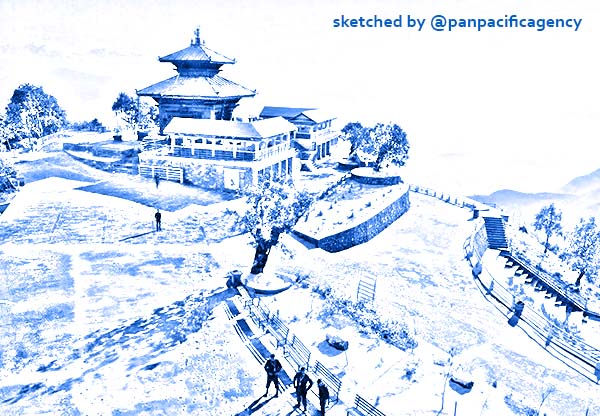[Analytics] Political turmoil does Nepal no favours

Chandragiri hill in Nepal. Photo: trekkingteamgroup.com. Sketched by the Pan Pacific Agency.
2021 was a year of political upheaval and continued global disconnect for Nepal, but it was also a year of economic recovery. Nepal saw the fury of COVID-19 in May 2021 when it reeled under a shortage of oxygen and medical supplies, queues at cremation centres and thousands of lost lives. By the middle of December 2021 nearly 12,000 people had died of COVID-19, more than had died as a result of the 7.8 magnitude earthquake in 2015. Sujeev Shakya specially for the East Asia Forum.
When 2021 began, it was unclear whether caretaker Prime Minister Khadga Prasad Sharma Oli — who had just come to office after parliament was dissolved in December 2020 — would last. In February 2021, the Supreme Court overturned the verdict that had let to Oli’s prime ministership. In May, the President Bidya Devi Bhandari again ordered the house to be dissolved. Parliamentarians who opposed this move took their case to the Supreme Court which overturned the President’s decision, warned the President not to meddle, and appointed Sher Bahadur Deuba of the Nepali Congress as Prime Minister. Parliament was non-functional for much of the year.
Deuba leads a fragile coalition comprised of people opposed to Oli and includes former prime ministers Pushpa Kamal Dahal and Madhav Kumar Nepal. It took Deuba three months to expand the cabinet which had barely started functioning when the annual festive season of Dasain and Tihar began. With major political party conventions in November and December, the focus was on selecting new leadership amid internal squabbles, lobbying, and upcoming elections.
Nepal’s relationship with India remained sour in 2021 due to territorial disagreements. Challenges in trade and transit continued to hog headlines, and Nepalese trade with China was impacted by COVID-19 and other natural calamities like floods and landslides. Now it appears that border disagreements have emerged with China as well for the first time since 1960, and this may have contributed to a lack of progress in Belt and Road investments last year.
Things aren’t looking great for the United States–Nepal relationship either. Public controversy over a US Millennium Challenge Corporation grant of US$500 million emerged with many opposing this grant alleging it to be a security sell-out to US. The lack of political will to implement an agreement signed between the two countries in 2017 clearly demonstrated the difficulties for Washington in working with Kathmandu.
Nepal’s relationships with other countries were limited to pleasantries at national holidays as Nepal recalled many appointed ambassadors. However, the country continues to enjoy people-to-people support in many countries around the world — medicine, medical equipment, oxygen and vaccines poured in during the second wave of COVID-19 in May.
The Nepali economy weathered the pandemic better than many others. With the exception of revenue from international tourists, all other economic activities continued mostly unbated. Remittances that come to Nepal from formal and informal channels increased. When formal remittances were down, remittances came in from of gold, through informal channels as imports surged and air travel resumed.
The performance of banks improved compared to 2020 deposits and credit grew from US$38 billion to US$46 billion by November 2021. The stock exchange saw record volumes and prices with total market capitalisation increasing from US$24 billion in October 2020 to US$30 billion in November 2021 with daily volumes peaking at US$150 million.
Imports and consumption showed signs of recovery as spending on festivities, social functions and religious functions picked up. Land prices ballooned and construction activities returned to pre-pandemic levels. The number of people departing for foreign education and jobs also started to recover as physical movement of people resumed in the latter half of the year. The hardly functioning government ensured weak regulation, promoting economic activity.
2022 will be an election year and the prelude of election activities has been visible at party conventions. It will be a year that sees more businesspeople enter the political arena and more politicians develop private sector alliances. It remains to be seen what new promising faces in politics emerge.
As far as the economy is concerned, Kathmandu needs to increase spending to manage the temporary liquidity crunch. It will be interesting to see whether the government will be able to implement reforms to attract international investment or whether policymakers will let protectionism proliferate. And of course, we will have to wait to see how damaging Omicron will be for Nepal’s economic activities.
Sujeev Shakya is the founding CEO of Kathmandu-based consulting firm Beed Management, Senior Advisor for Nepal and Bhutan at BowerGroupAsia and Chair of the Nepal Economic Forum. He is author of Unleashing Nepal (Motilal Penguin India 2009) and Unleashing the Vajra (India Viking 2019).